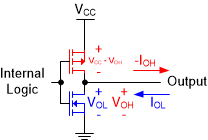FAQ: Logic and Voltage Translation > Output Parameters >> Current FAQ
The high logic level output voltage of a logic device with no load will be the supply voltage.
The output current of a logic device is determined by the load connected to the device and the strength of the output driver
It's important to note that VOH or VOL is always given together with a test current (IOH or IOL, respectively).
For example:
An ideal 5-V logic gate (ideal := 0 Ω output impedance) connected to a 100 Ω load will be outputting IOH = VCC/100 = 50 mA with VOH = 5 V
A more realistic 5-V logic gate with a 25 Ω output impedance will be outputting IOH = VCC/(100+25) = 40 mA with VOH = VCC*100/(100+25) = 4 V
Figure 1. Equivalent output structure for a push-pull output CMOS logic device.
The questions we get on this topic typically come in one of two forms, and I will cover each separately. Both of these are fairly complex questions that deserve more than a single FAQ post, however I will try to give a quick and easy answer to help the reader.
(1) The datasheet gives VOH or VOL at supply of X and I need the VOH or VOL at supply value Y.
Assuming you keep the output current the same, the voltage _drop_ at the output will be maintained when VCC is at or slightly above the value given in the datasheet. For example, if the datasheet says the VOH at 3-V supply is 2.7V, then the voltage drop is 3 - 2.7 = 0.3V. If you change the supply to 3.3V, then it is safe to say that the minimum VOH will now be 3.3 - 0.3 = 3 V.
VOL is even easier, with the VOL remaining the same -- ie a VOL of 0.55 at 4.5-V supply will still be a VOL of 0.55 V at 5-V supply.
If you need a more precise value, linear interpolation between the given datasheet values, or linear extrapolation beyond the datasheet values, can be used to directly find the correct values. Just be sure to (a) use the closest 2 values in the datasheet to do the inter-/extra-polation and (b) hold all other values constant.
This FAQ has some additional details that may be helpful:
(2) The datasheet says IOH or IOL is X mA at Y supply voltage. I need to know the output current at Z supply voltage.
This is a trickier question to answer -- it appears that there is some confusion in the definition of IOH and IOL.
IOH and IOL are defined as the currents at which the VOH and VOL values in the datasheet are tested. These current ratings give a good idea of the maximum recommended output current of a logic gate, however they do not indicate a limit for the device.
For example:
A 5-V supply, 15-Ω output logic device lists an IOL of 24 mA, and a 35 Ω resistor is connected from the output to 5 V.
The current produced will not be limited to 24 mA; it will be governed by Ohm's Law: IOL = (VCC)/(15 + 35) = 100 mA.
For most logic devices, this would cause damage to the device, and likely the system.
This FAQ has some additional details that may be helpful:
-
If you need to know the maximum current ratings of a device, please refer to the Absolute Maximum Ratings table in the datasheet. There you will typically find an absolute maximum rating of current for each output and an absolute maximum rating of current total for the device (often referred to as "current through Vcc or ground")


